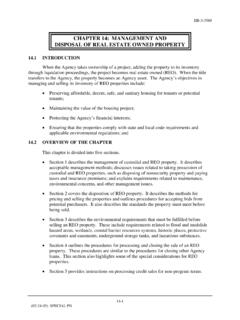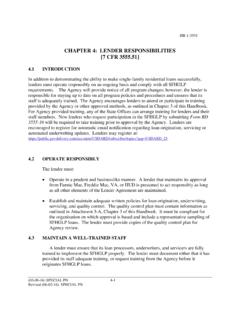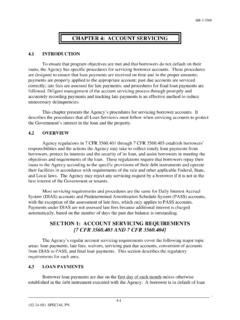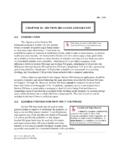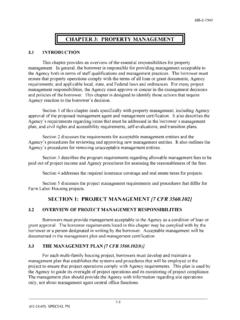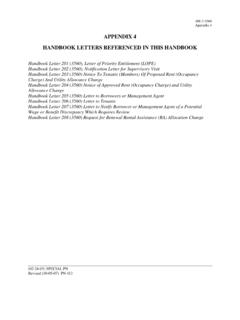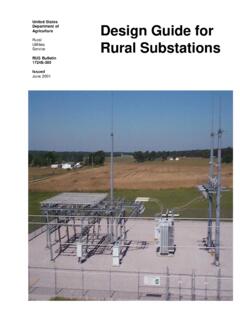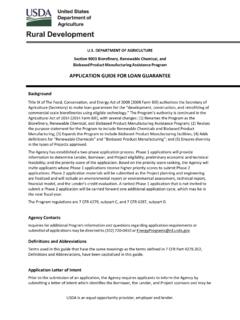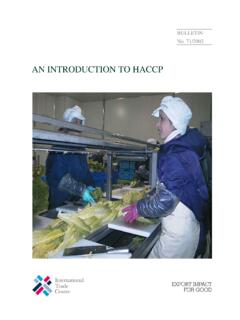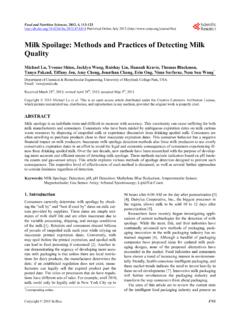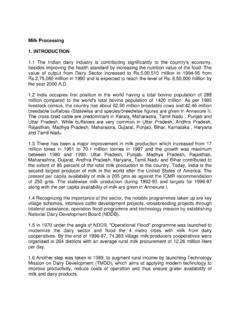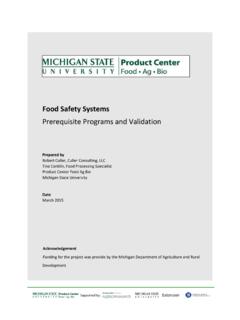Transcription of An Introduction to Cooperatives - USDA Rural Development
1 CICo-ops 101An Introduction to CooperativesCooperative Information Report 55 United States Department of AgricultureThis report provides a comprehensive summary of basic informa-tion on the cooperative way of organizing and operating a business. It covers the nature and extent of the use of Cooperatives , compares Cooperatives to other business structures, explains the roles vari-ous people play in a cooperative , and discusses equity accumulation and income taxation. The purpose is to make available, in a single report, the information someone would need to acquire a general understanding of how Cooperatives : cooperative , Business, Finance, Structure, TaxCo-ops 101: An Introduction to CooperativesDonald A.
2 Frederick wrote this report in 1997 and revised it in 2005. This latest revision was completed by James J. Wadsworth and E. Eldon Eversull. cooperative Information Report 55 April 1997 Revised November 2012 Publications and information are also available on the RBS web-site: : for more mention of brand-names, trademarks, and company names in this publication is for illustrative purposes only, and in no way con-stitutes endorsement of any commercial enterprise or to the dynamic world of cooperation people working together to solve common problems and seize exciting opportuni-ties. Cooperatives are business entities that people use to provide themselves with goods and booklet introduces you to the attributes that distinguish a cooperative from other ways to organize and conduct a business.
3 Its purpose is to help you understand what makes a cooperative unique. It contains a great deal of information to absorb. Use it as a reference and refer to it when specific problems arise. Over time, you will learn more about Cooperatives and your experience with them should be more of ContentsIntroduction ---------------------------------------- ------------ 1 Chapter 1. A Historical Perspective ----------------------------- 3 Chapter 2. cooperative Principles and Practices ----------------- 9 cooperative Principles ------------------------------------ 9 The User-Benefits Principle ---------------------------- 9 The User-Owner Principle ---------------------------- 10 The User-Control Principle --------------------------- 10 Related Practices ---------------------------------------- - 11 The Patronage Refund System ------------------------ 11 Limited Return on Equity Capital -------------------- 13 Cooperation Among Cooperatives -------------------- 13 Chapter 3.
4 Cooperatives in the Community -------------------- 15 Commercial Sales and Marketing Cooperatives ----------- 16 Financial Cooperatives ----------------------------------- 20 Social and Public Services Cooperatives ------------------ 22 Chapter 4. Benefits of Cooperation ---------------------------- 25 Chapter 5. Business Organizations ----------------------------- 31 Individually Owned Businesses --------------------------- 31 Partnerships ---------------------------------------- ----- 32 General Business Corporations --------------------------- 33 Limited Liability Company ------------------------------ 35 cooperative ---------------------------------------- ------ 36 Chapter 6.
5 Classifying Cooperatives by Structure --------------- 39 Geographic Territory Served ----------------------------- 39 Governance System -------------------------------------- 39 Functions Performed ------------------------------------- 40iiiChapter 7. People ---------------------------------------- ------ 45 Members ---------------------------------------- -------- 45 Directors ---------------------------------------- --------- 48 Officers ---------------------------------------- ------ 50 Board Committees ----------------------------------- 51 Managers ---------------------------------------- -------- 52 Employees ---------------------------------------- ------- 54 Chapter 8.
6 Sources of Equity ----------------------------------- 57 Direct Investment ---------------------------------------- 58 Retained Margins ---------------------------------------- 59 Per-Unit Capital Retains --------------------------------- 60 Nonmember/Nonpatronage Earnings -------------------- 61 Chapter 9. Financial and Tax Planning ------------------------- 63 Cash Refunds ---------------------------------------- ---- 63 Qualified Retains ---------------------------------------- 64 Nonqualified Retains ------------------------------------- 66 Unallocated Reserves ------------------------------------- 67 Chapter 10.
7 Equity Management ------------------------------ 69 Revolving Fund Plan ------------------------------------- 69 Special Plans ---------------------------------------- ----- 70 Base Capital Plan ---------------------------------------- 71 Conclusion ---------------------------------------- ------------ 72 Notes ---------------------------------------- ----------------- 73ivIntroduction1 There is no universally accepted definition of a cooperative . In general, a cooperative is a busi-ness owned and democratically controlled by the people who use its services and whose benefits are derived and distributed equitably on the basis of use. The user-owners are called members.
8 They benefit in two ways from the cooperative , in proportion to the use they make of it. First, the more they use the cooperative , the more service they receive. Second, earnings are allocated to members based on the amount of business they do with the many ways, Cooperatives resemble other businesses. They have similar physical facilities, perform similar functions and must follow sound business practices. They are usually incorporated under state law by filing articles of incorpora-tion, granting them the right to do business. The organizers draw up bylaws and other necessary legal papers. Members elect a board of directors. The board sets policy and hires a manager to run the day-to-day in some ways, Cooperatives are distinctly different from other businesses.
9 These differences are found in the cooperative s purpose, its owner-ship and control, and how benefits are distrib-uted. They are reflected in cooperative principles that explain the unique aspects of doing business on a cooperative courtesy Dairy Farmers of America Chapter 1A Historical Perspective3In one sense, cooperation is probably as old as civilization. Early people had to learn to work together to meet their common needs, or per-ish. The Pilgrims who settled at Plymouth, MA, jointly cleared fields abandoned by the Indians, broke up the soil, and planted and cared for their corn. After the harvest, celebrated with the Indi-ans in 1621 with a Thanksgiving feast, the corn was shared equally among the suggests that the initial structured cooperative business in the United States was the Philadelphia Contributionship for the In-surance of Houses from Loss by Fire, a mutual fire insurance company established in 1752.
10 This association s reputation is likely based on two factors. First, Benjamin Franklin was the orga-nizer. Second, the business has been conducted so efficiently over the years that it is still operating the early 1800s, cooperative businesses ap-peared on several fronts. In Britain, Cooperatives were formed as a tool to deal with the depressed economic and social conditions related to the struggles with Napoleon and industrialization. In the United States, farmers began to process their milk into cheese on a cooperative basis in diverse places such as Goshen, CT, and Lake Mills, WI. Writers sometimes trace the origin of coop-eratives from the Rochdale Equitable Pioneers Society, an urban, consumer cooperative orga-4nized in England in 1844.
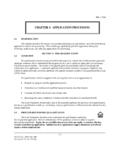
![CHAPTER 14: FUNDING [Official Agency Use Only]](/cache/preview/5/1/5/b/5/3/5/c/thumb-515b535cec62fd2bb25fbb788ef1c7a2.jpg)
